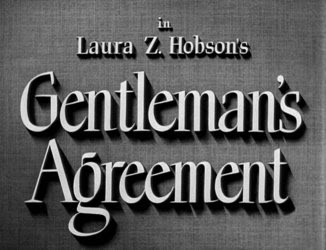Gentleman's Agreement

As promised, I'll be posting more 1947 films I've seen before starting the project. Of those, none exemplify the qualities of postwar Hollywood I'm so interested in more than Gentleman's Agreement (Elia Kazan, 20th Century-Fox). A social problem film par excellence, the film represents the directions of the postwar prestige film, particularly the house style of 20th-Fox. This style comprised two qualities.
First a pseudodocumentary impulse and its integration into the fictional narration. The opening shot starts off like many of the 47 films:



The camera pans left and tilts down, with a narrational emphasis, signalling that the story we are about to see is one of many going on in New York City (The Naked City will make this conceit explicity). The next shot fulfills the expectation with Phil Green (Gregory Peck) and son (Dean Stockwell) strolling in midtown.
This realist trope is but part of a continued sociological gaze of the narrative. 20th Fox's prestige films in general were set in a solidly white collar milieu. Gentleman's Agreement moreover makes its problem film about "country club" anti-Semitism, where literally about resorts...

... or more generally about the various haute bourgeois and white collar locales of prejudice. (Notably, Phil Green passes as Jewish as part of his investigative journalism.) My book-in-progress is exploring, among other things, the ways that the film signals locale in sociologically specific ways, from the parkside residence to the more modest apartment building befitting a newspaper writer.


The point, of course, is not that these are fully verisimilar, denotiig spaces as actually inhabited by their social types. (In general, Hollywood set design prefers flat surface, regardless of context). But the specificity does strike me a change from a generalized creation of "city," "rich," or "poor" in 30s set design.
Alongside the realist tropes, the camera style marks the prestige filmmaking. One good example is a shot during a party scene. Phil talks to vampish fashion editor Ann Detrie (Celeste Holme). Simple, yet complex, the take lasts 1m15sec and tracks three times left to reframe the characters as they take in the buffet. The staging is similar to a following shot in today's film/TV, but here the classical planning is controlled and evidenct. It's striking in its unobtrustiveness, since the tracking shot does not serve stylistic flourish or even emotional emphasis, but rather serves almost as a secondary marker to distinguish 20th's prestige filmmaking from lesser, more pedestrian stagings that Hollywood might normally do of this scene.




It's worth noting that the film was pretty much Fox's biggest success story of 47, bringing critical praise, Academy awards, and strong box office receipts on a decent but reasonable A budget of c. $2M. For reference, The Late George Apley, The Ghost and Mrs. Muir, and Nightmare Alley all cost about that much.
Comments